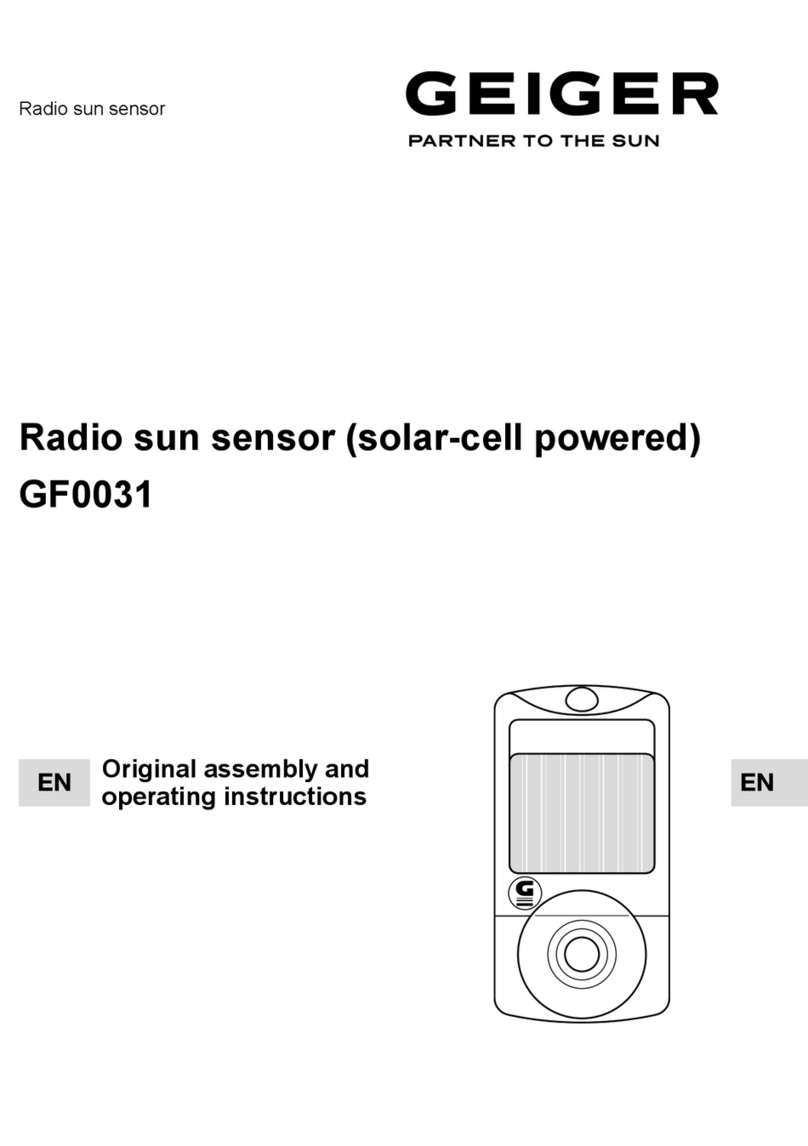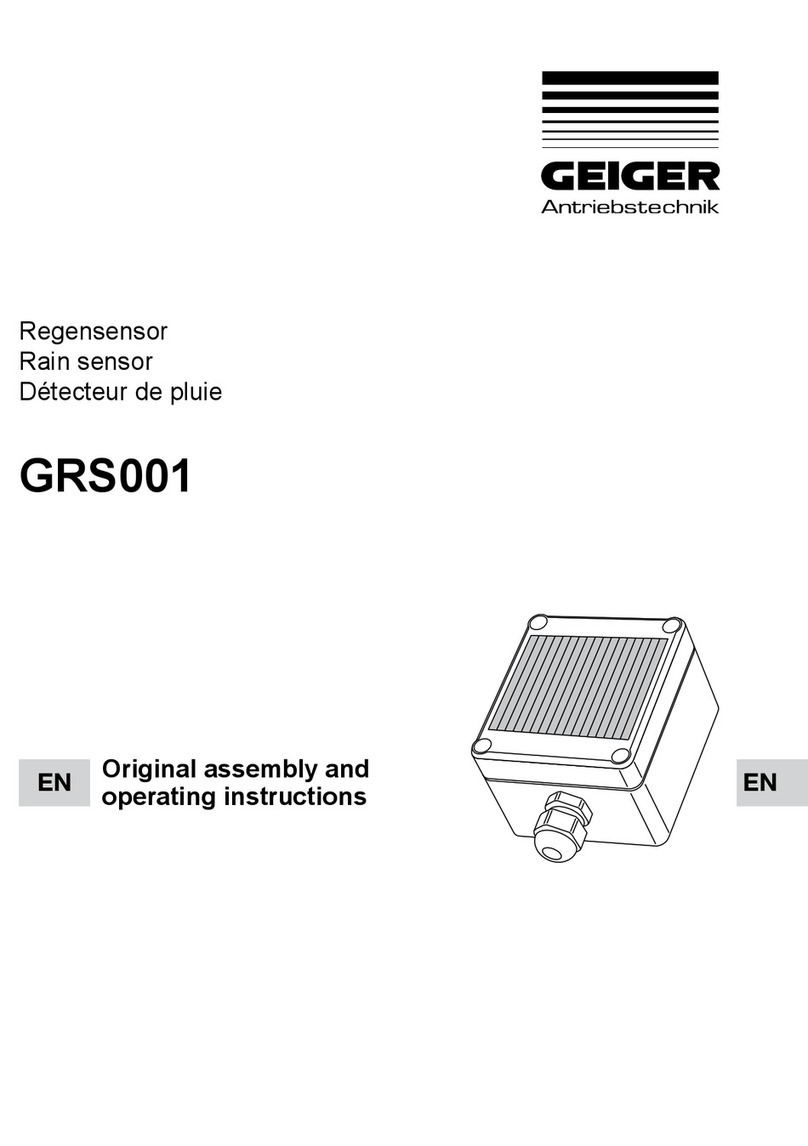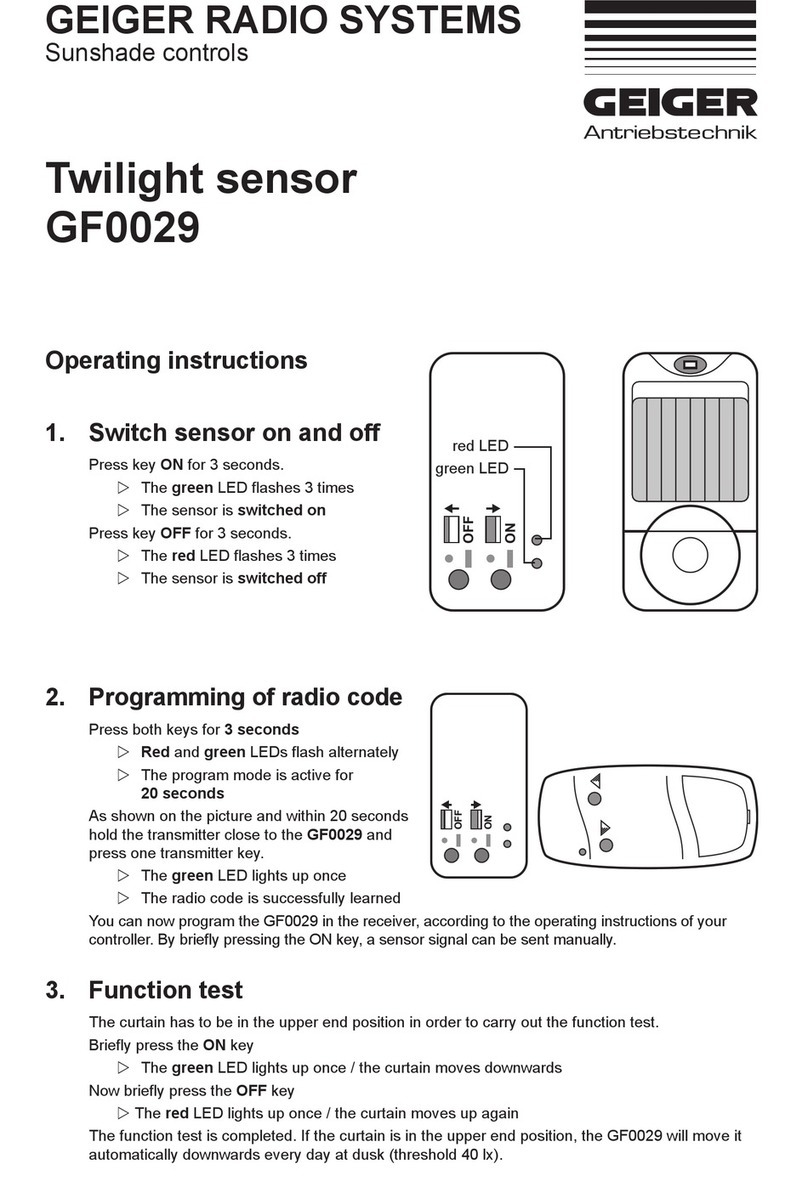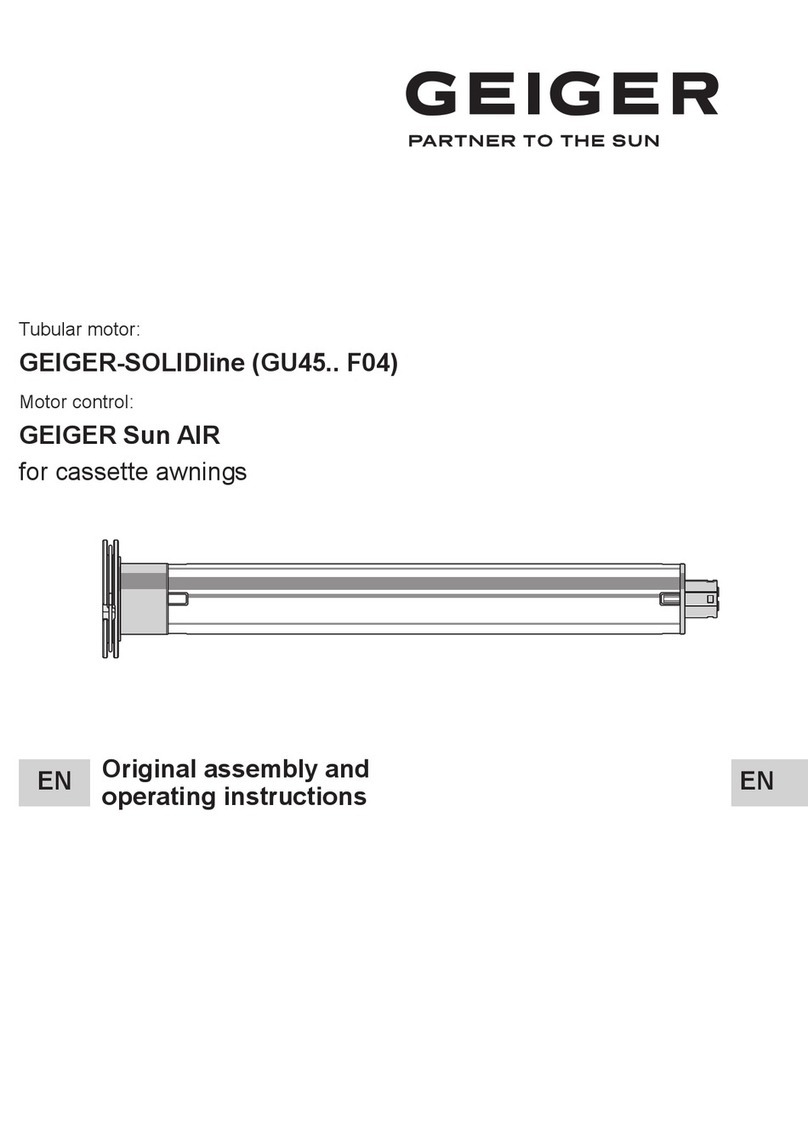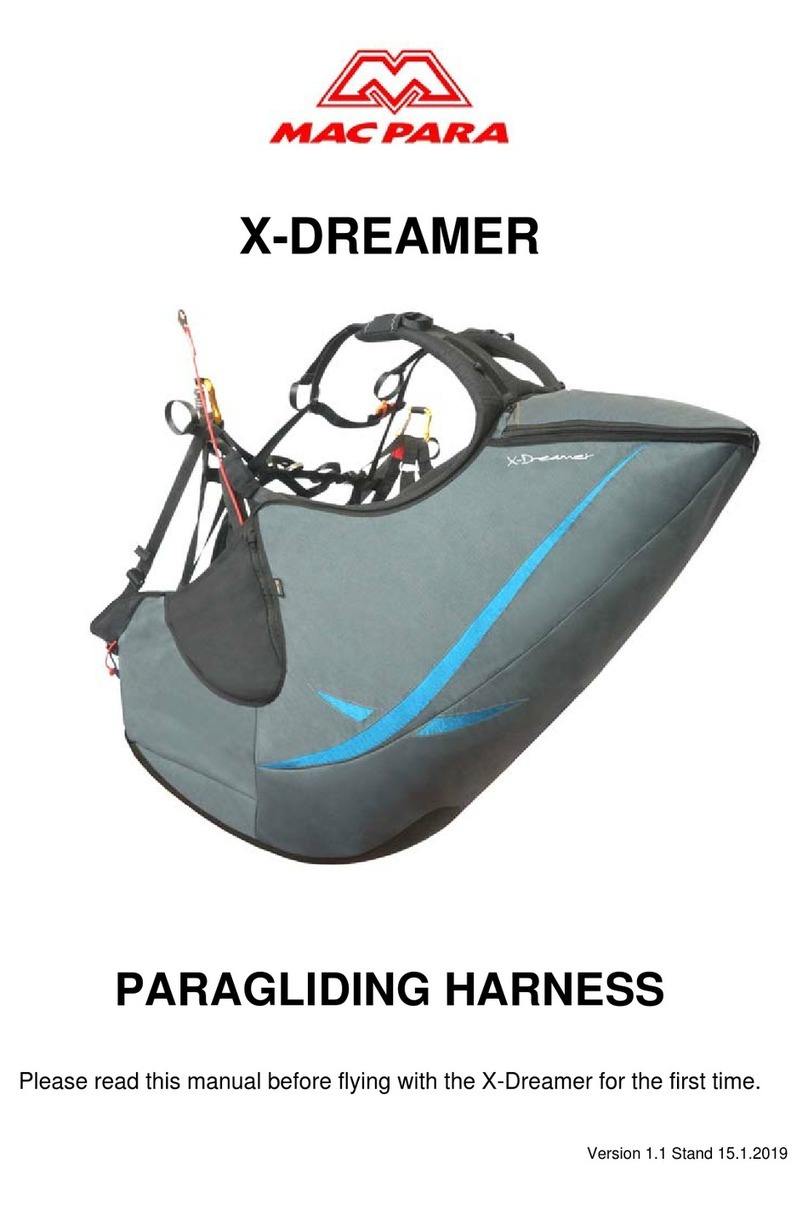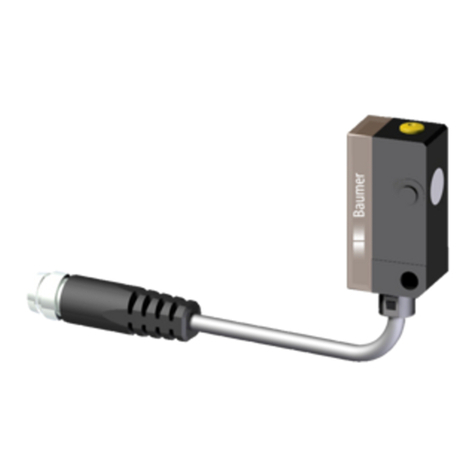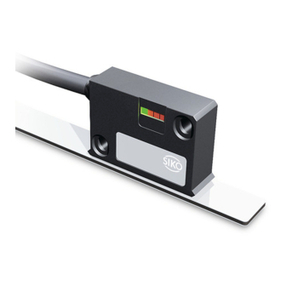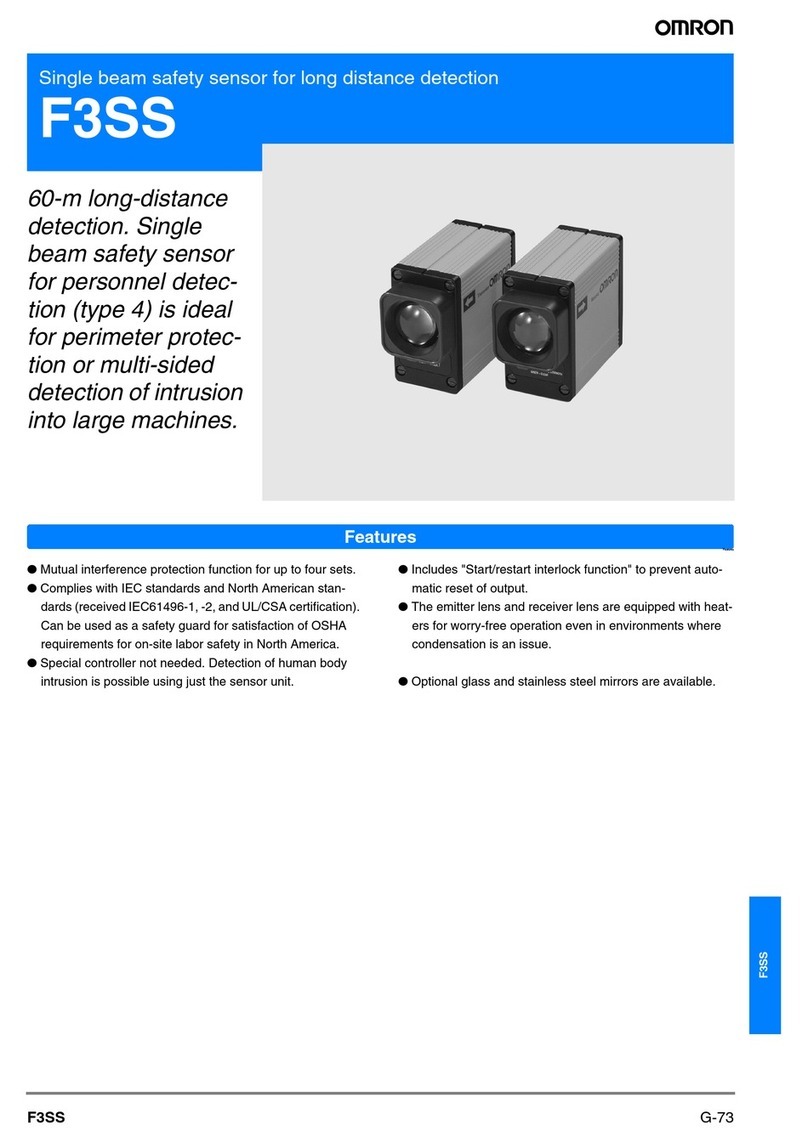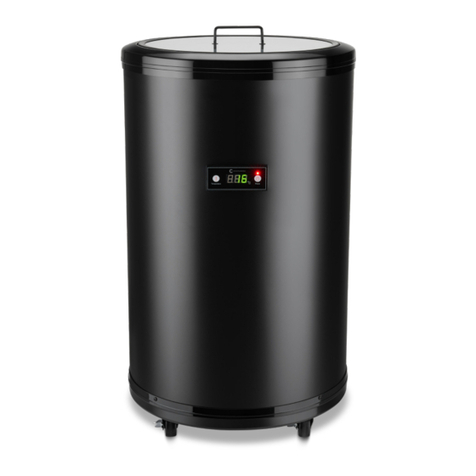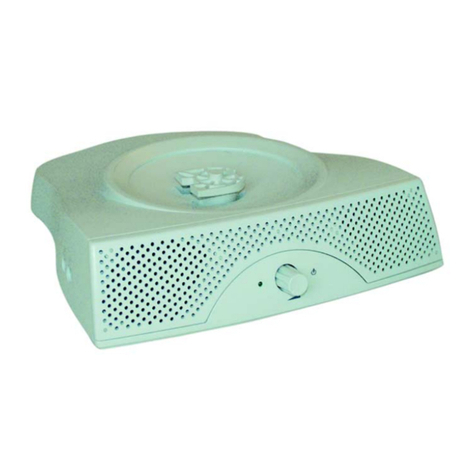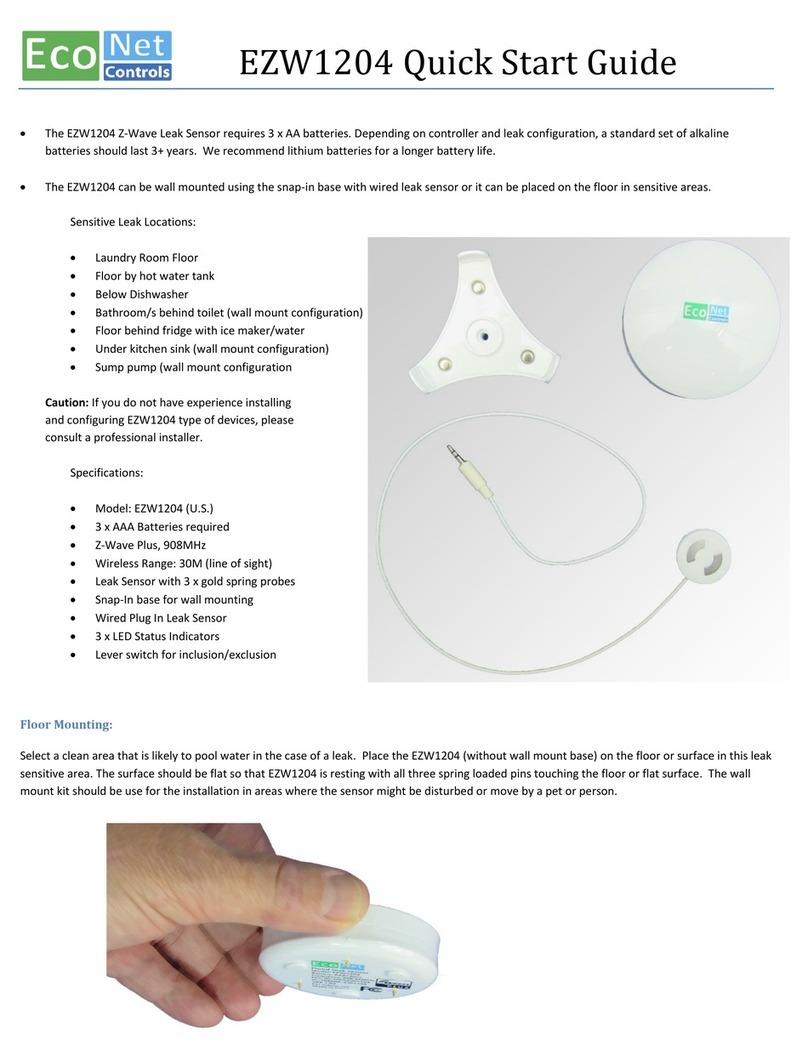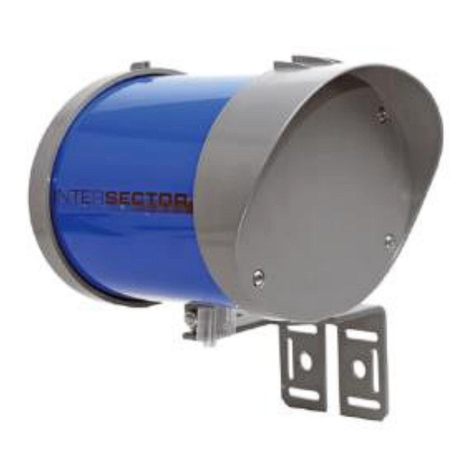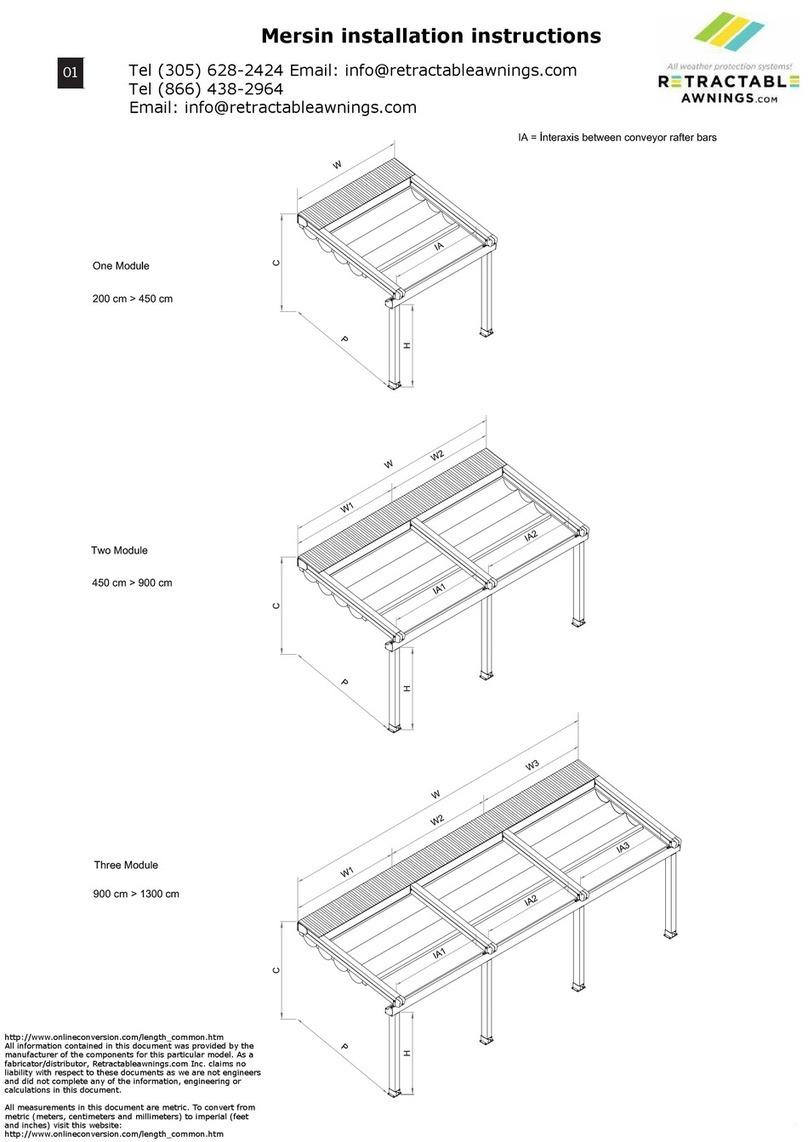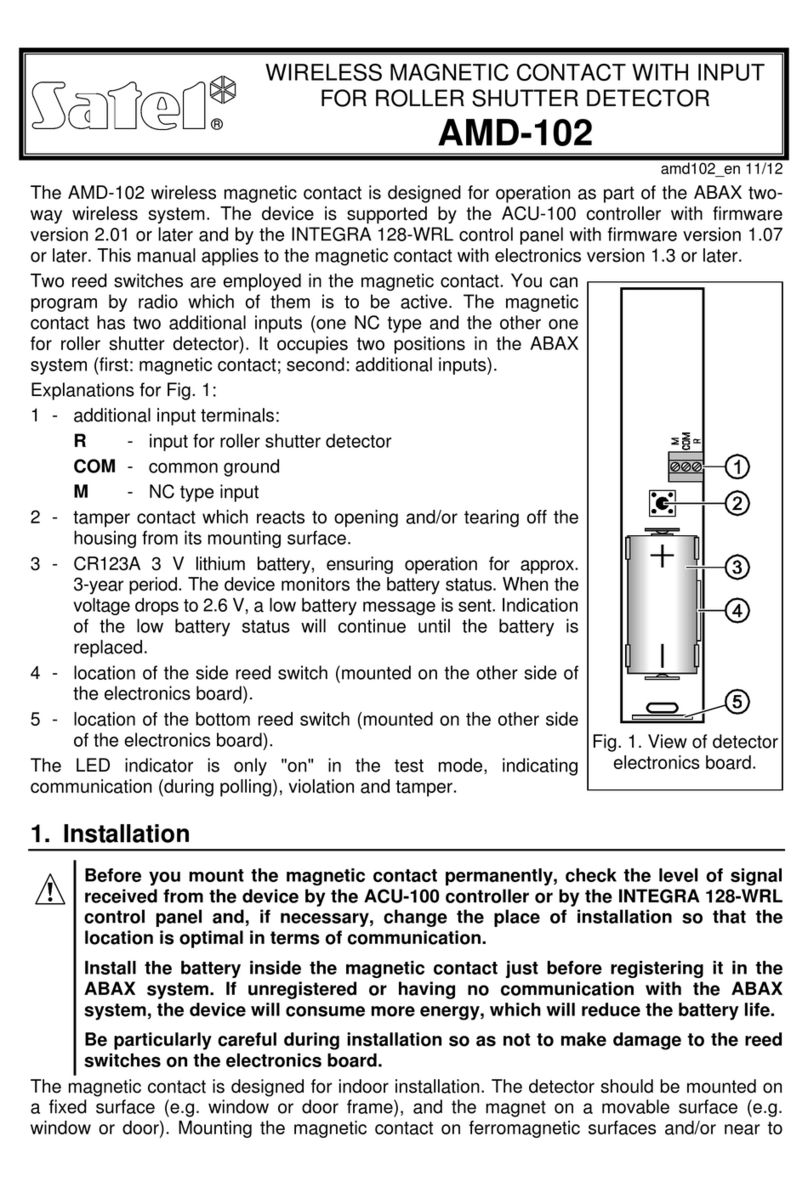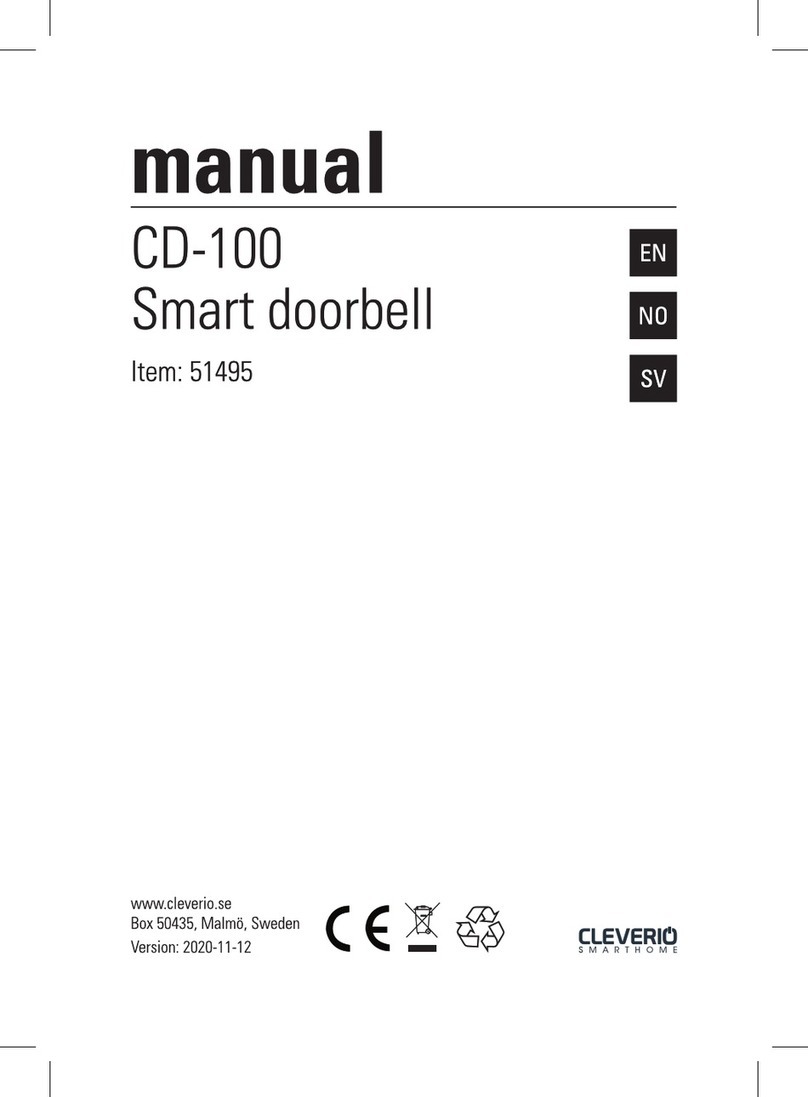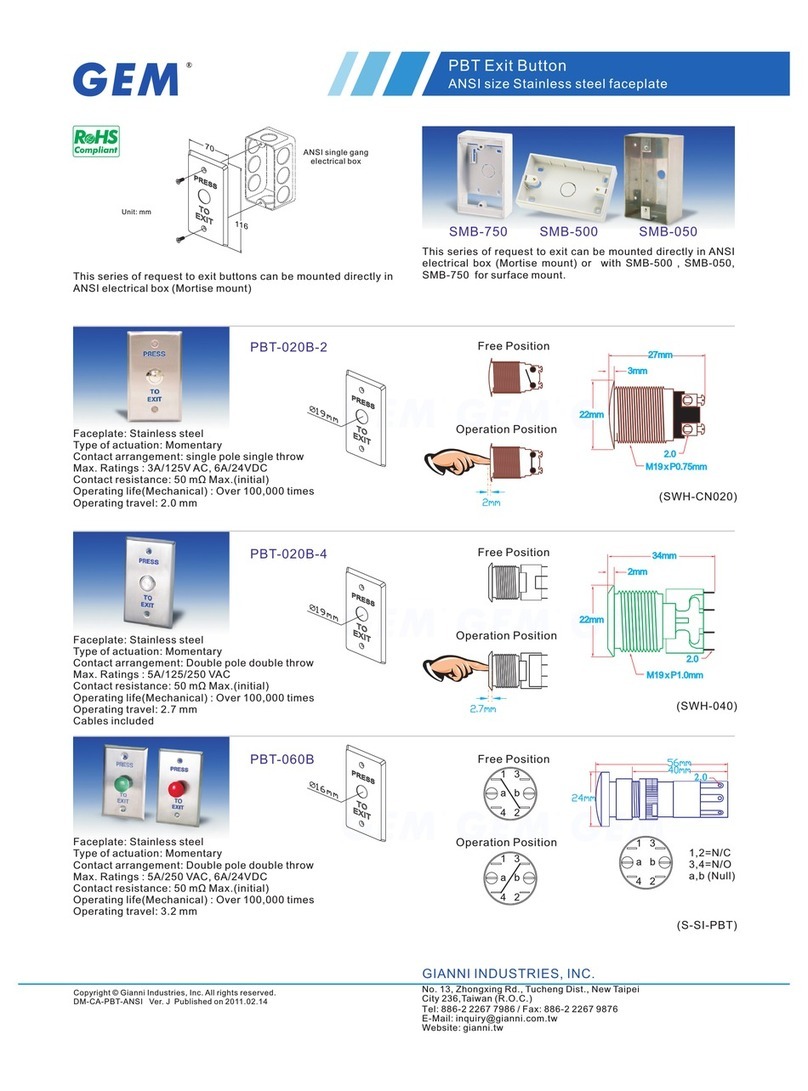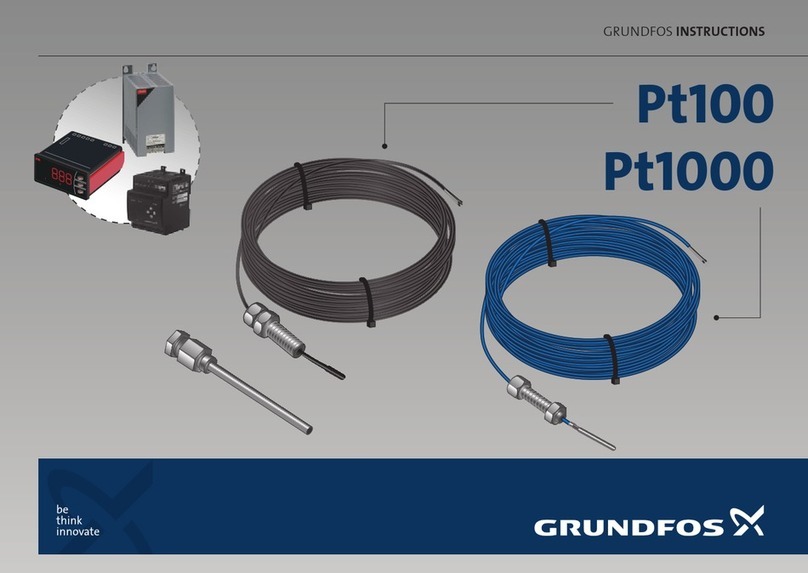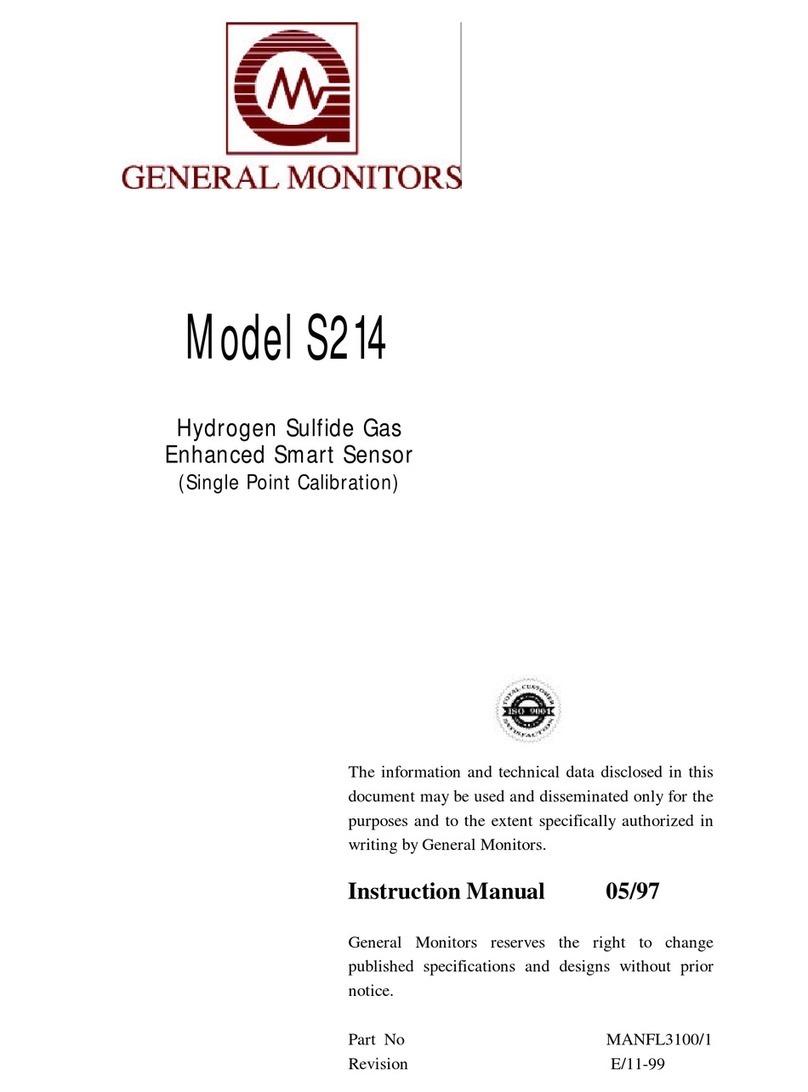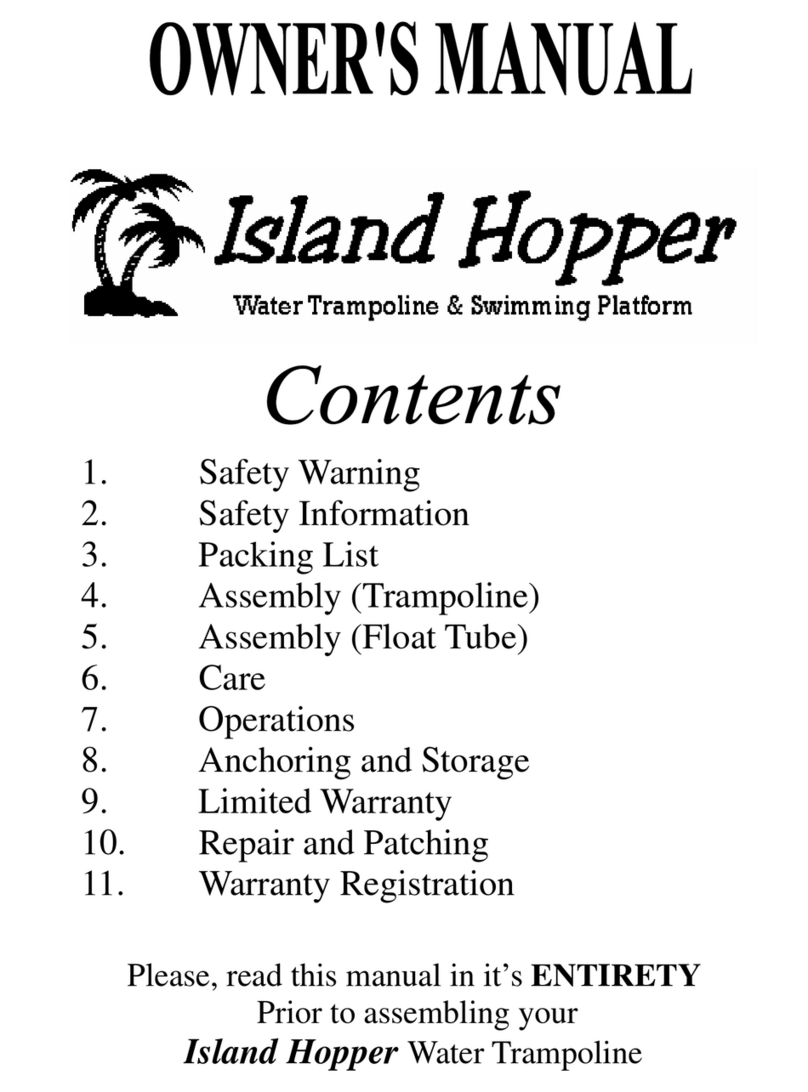GEIGER GFM001 User manual

EN
Awning control system
for 230V drives
for pre-coded systems
GFM001
Installation and operating instructions

2
able of Contents
1Introduction........................................................................................................................................3
2 Safety instructions .............................................................................................................................3
3 Specified application..........................................................................................................................3
4 Installation and connection................................................................................................................4
4.1 Mounting information..............................................................................................................4
4.2 Connection diagram G M001 ................................................................................................4
5 irst start-up and commissioning ......................................................................................................4
6 Control functions................................................................................................................................5
6.1 Manual operating functions ....................................................................................................5
6.2 Automatic operating functions................................................................................................5
7 Extensions and individual settings ....................................................................................................6
7.1. Learning of radio commands .................................................................................................6
7.2 Coding set in the condition as delivered ................................................................................6
7.3 Learning of the coding of a hand-held transmitter .................................................................6
7.4 Learning of a sensor ..............................................................................................................7
7.5 Learning of intermediate positions .........................................................................................7
7.6 Cancelling of intermediate stop positions ..............................................................................7
7.7 Interchanging of the relay assignments .................................................................................8
7.8 Cancelling of all learned settings and codes .........................................................................8
8 Audible signals emitted by the control for fault diagnosis .................................................................8
9 Technical characteristics ...................................................................................................................9
10 Declaration of Conformity..................................................................................................................9

3
1 Introduction
By deciding to buy the awning control system G M001 you have made a good choice. The device you
have acquired is a high quality product made by Geiger.
The control system has been designed for the exclusive operation via radio commands.
The system can be operated in the following manner:
• By way of manual operation by means of hand-held- and wall-mounted radio transmitters.
• Through the execution of an automatic program based on the data sensed by special radio sun,
wind and rain sensors.
• In a time-controlled manner via clock-controlled radio transmitter.
The individual radio commands can be allocated to and are operative with regard to the following
control options:
• Control of individual systems
• Control of a group of systems (arbitrary number of receivers within reach)
• Central control (arbitrary number of receivers within reach)
2 Safety Instructions
• or operation, the awning control system G M001 requires a supply voltage of 230 VAC, 50 Hz.
Please pay attention to the fact that the control system may only be installed by an expert electrician
(according to VDE 0100).
• The control system is only determined for use within the limits of the specified application described
in section 3 herein. Unauthorised changes of and/or modifications to the control system will result in
the invalidity of all warranty claims.
• Immediately after its unpacking, the control system must be checked for damages. The device must,
in case damages are detected, in no case be put into operation. Once transport damages have
been detected, the supplier of the device has to be notified thereof immediately.
• Whenever it is to be assumed that the device cannot be operated safely, it has to be put out of
service immediately and be protected against unintended operation. This is the case if the housing
or the mains power or motor supply lines have been damaged or if the device doesn't work
anymore.
• Both the operator and the firm charged with the installation of the device are, as specified in VDE
0022 (German regulations for electrics), themselves responsible for their complying with the relevant
regulations issued by the local power supply company or the relevant VDE regulations.
• Prior to performing any works on awnings that are driven and controlled by a G M001 control
system, always make sure to power off the supply voltage first.
3 Intended Usage
The awning control system G M001 may only be used to drive 230 VAC, 50 Hz, one-phase motors.
When installing the control system G M001, care has to be taken to protect the device against the
exposure to water jets (IP54).
When cleaning the awning, never wash down the control directly by means of a water hose or a
high-pressure cleaning device.

4
4 Installation and connection
4.1 Mounting information
The distance between two G M001 control systems should come to at least 0.5 meter.
4.2 Connection diagram GFM001
5 First start-up and commissioning
• Adjust the motor limit switch as prescribed by the manufacturer of the device.
• Ready! The pre-coded system can now be operated radio controlled!
• Actuate the keys and let them go again after the indicated time:
“ON” The awning moves, in lock condition, until
approx. 0.5 to 2 seconds: to upper stop position (RETRACTING).
“O ” The awning moves, in lock condition, until
approx. >1.5 to 3 seconds: to lower end position (EXTENDING).
“Travel direction counter-key” Actuating the counter-key stops the
approx. 0.5 to < 1.5 seconds: travelling motion immediately.
“Repeated actuation” The travelling operation is
in travel direction: continued without interruption.
“O in IP” Actuating this key shortly causes the
approx. 0.5 to < 1.5 seconds: awning to move to a learned
intermediate stop position.
Important information:
The control system G M001 may transiently be disabled for manual operation.
This may happen if learned sensors emit so-called "protect commands".
Disabling times: Wind or rain command = 10 minutes,
Service command = 5 minutes
Depending on the installation position of the
drive, the sense of rotation must be changed.
here are two options to do so:
1. By changing the two motor connection
cables (black and brown cable).
2. By changing the relay allocation via radio
transmission (see sub-chapter 7.7).

5
6 Control functions
6.1 Manual operating functions
Generally, the following applies: The control system is equipped with a fixed motor running time
limitation of 140 seconds for the extension of the awning and of a limitation of 155 seconds for its
retraction.
An arbitrary intermediate stop position can be learned while operating in extracting mode, which is then,
upon according operation, approached both in manual and automatic mode operation.
A "learned" intermediate stop position is approached only during the extension of the related awning.
Awnings that, upon "power on", are not in end position (retracted completely) need, prior to approaching
an intermediate stop position, first be homed or synchronized with this position. To realise this, retract
the awning completely first and then wait for 155 seconds.
Operation via hand-held radio transmitter:
No more than maximum three differently pre-coded hand-held radio-controls can be used for the
operation of one control system. Each transmitter disposes of at least two command keys that have
been allocated to each of the awning travel directions, i.e. "UP" (Auf = retracting) and "DOWN"
(Zu = extracting). Actuating the counter-key of the actually operated key triggers a stop command.
Actuating the key "DOWN" (Zu) shortly (< 1.5 seconds) effectuates that an initially retracted awning is
extended up to a "learned" intermediate stop position upon the attaining of which the travel motion is
stopped.
Actuating the key "DOWN" (Zu) for somewhat longer (>=1.5 seconds) effectuates that an initially
retracted awning is extended up to its end position (motor runtime = 140 seconds).
Any actuation of the key "DOWN" (Zu) after the attaining of an intermediate stop position effects that
the awning is extended over the term of the remaining runtime.
Any actuation of the key "UP" (Auf) after the attaining of intermediate stop position effects that the
awning is retracted over the term of the remaining runtime plus a 15 seconds reserve time.
6.2 Automatic operating functions
The coding of at least one sensor has to be "learned" first in order to enable the automatic radio-sensor
based operation of the control system. In the event a sensor coding has been learned, the control
responds, provided the related sensor or other transmitter has been coded accordingly, to the reception
of the following radio commands: "sun", "wind", "rain", "service" and "sun automatic ON/O ".
Activation / deactivation of the sun automatic mode:
The automatic, sun sensor triggered operation of the system can be activated or deactivated by radio
commands.
The activation or deactivation can be effected by means of the special control keys "Automatik-Ein"
(automatic ON) and "Automatik-Aus" (automatic O ) that are available on specially equipped
hand-held transmitters.
These commands can be triggered at any time, even while the awning is in motion. An "automatic
O " command can only be undone by triggering an "automatic ON" command. A short motion of the
awning in both travel directions indicates the activation or deactivation of the automatic mode. In the
event the awning is in motion at the time the related command is triggered, the retraction or extension
operation currently performed is continued after the execution of the above mentioned indication travel.
All actually triggered commands are stored in a power failure safe manner.
Caution! The manual operation of the control system overrides the operation in sun automatic mode.
Any manually triggered operating command, which effects that the corresponding motor relay is activat-
ed, interrupts the sun sensor triggered automatic mode operation.

6
The automatic operation of the control system can be reactivated by when proceeding as describe below
(points 2 and 3 do apply only subject to the condition that automatic mode is activated as for standard).
1. Triggering an "automatic ON" command (possible via special hand-held transmitters) can activate the
sun automatic.
2. The automatic mode is, after any interruption by way of manual interference, reactivated again once
the awning has run in (retracted) completely and only after the expiry of the 155 seconds motor run
time.
3. An integrated timer function reactivates the automatic mode again after any interruption by way of
manual interference. The restoration of the automatic mode takes place four hours after the time the
awning control system has last been operated manually.
This is to ensure that the awning will be retracted upon the receipt of the next "sun dark" radio command
that has been transmitted one of the sun sensors.
7 Extensions and individual settings
7.1 Learning of radio commands
The control is, in total, equipped with 8 memory locations for the storage of radio codings. 3 x 2 memory
locations have been provided for the hand-held transmitter related codings and 2 for sensor related
codings. All hand-held transmitters are, in each case, equipped with 2 keys that work in counter-keying
mode and. Each of them occupies 2 memory locations. Sensors, by contrast, occupy one memory
location each only.
7.2 Coding condition as delivered
The coding preset by Geiger can be learned from the picture shown left hand (coding condition as
delivered). If several control systems are to be installed that
shall be operated individually, each radio receiver must get its
individual coding.
This can be realised by changing at least one of the DIP
switches 1 to 6 in such manner that always a different coding is called into being. Also please use the
zero position of any of the DIP switches in order to do so.
7.3 Learning of the coding of a hand-held transmitter
1. Use the DIP switches (switches 1 to 6) in order to set the desired individual coding at the related
hand-held transmitter.
2. Power off and on the power supply of the awning control system shortly (overall time available for
the execution of the learning procedure as of this moment: 10 minutes)
3. Hold the hand-held transmitter close to the antenna of the G M… control system and keep the key
"AU " (UP) or "AB" (DOWN) depressed for approx. 3 sec. ¨An audible signal resounds. Then let
the key go (radio transmission stop).
4. The control requests, through the emission of short audible signals, the learning of the "UP" or
"DOWN" command. To do so, hold the hand-held transmitter close to the antenna and actuate
the key "AU " (UP) or "AB" (DOWN) for approx. 1 sec. ¨The control emits an audible signal for
acknowledgement.
5. After that, the control generates the counter-key now that has not yet been actuated in a self-acting
manner. While doing so, the control "learns" both travel directions all automatically. It stores the
codings learned by it in a power failure safe manner and changes all automatically over to normal
operating mode.
6. Once this has been completed, a second and a third code setting too can be learned. Learning a
fourth code setting, however, will overwrite the previously learned third setting.

7
7.4 Learning of a sensor
1. Power off and on the power supply of the awning control system shortly (overall time available for
the execution of the learning procedure as of this moment: 10 minutes).
2. Hold the hand-held transmitter close to the antenna of the G M… awning control and keep the key
"AU " (UP) depressed for approx. 3 sec. ¨An audible signal resounds.
3. After that, hold the sensor or special transmitter to be learned at least 1 metre away from the antenna
and actuate it shortly. ¨The control acknowledges by emitting an audible signal and changes all
automatically over to normal operating mode. The sensor learning procedure is now completed.
4. A second sensor coding can be learned now.
7.5 Learning of intermediate positions
he following should be noted with regard to this learning procedure:
Regarding the awning extension procedure, intermediate stop positions can be learned on a timeline
from 5 to 140 second. The restriction of the timeline ensures that no other than intermediate stops can
be learned that the operator can actually perceive as such.
he learning of intermediate conditions is enabled only subject to the condition that
the awning must have been retracted completely and that the motor run time has
expired (155 sec.).
The learning procedure can be performed in a convenient manner while operating in normal operating
mode. All actually learned hand-held transmitters can be used for this purpose. Learned intermediate
positions can, for extending purposes, be displaced at any time on the aforementioned timeline.
o learn an intermediate position, proceed as follows:
1. Use the related transmit key in order to trigger and "EXTENDING" motion travel and keep the key
depressed for approx. 5 seconds while doing so.
2. The drive motor stops after 4 seconds, shortly moves in "EXTRACTING" travel direction, stops
again and continues moving in "EXTENDING" direction.
The "learning" of an intermediate position has thus been initiated and the transmit key can be left off.
3. Stop, upon the attaining of the desired intermediate position, the moving sun shade by actuating the
related counter-key and hold this key depressed for approx. 5 seconds.
4. After the expiry of 4 seconds, the learned intermediate stop position is stored in a power failure safe
manner.
5. The awning performs, in order to confirm that the learning procedure has been successful, a short
movement in both travel directions. The counter-key can now be let off again.
7.6 Cancelling of intermediate stop positions
1. Use the related transmit key in order to trigger and "EXTENDING" motion travel and keep the key
depressed for approx. 5 seconds while doing so.
2. The drive motor stops after 4 seconds, shortly moves in "EXTRACTING" travel direction, stops
again and continues moving in "EXTENDING" direction.
3. Wait for another 5 seconds after the attaining of the end Position, then actuate the counter-key
(RECTRACTING) for 5 seconds until the control systems triggers a short travel motion of the
awning. The cancellation of the intermediate position is now completed.

8
7.7 Interchanging of the relay assignments
1. Power off and on the mains voltage (overall time available as of this moment for the execution of
this procedure: 10 minutes).
2. Hold the hand-held transmitter (e.g. G 0001) close to the antenna of the G M001.
3. Keep the key "AU " depressed for approx. 3 sec. until an audible signal resounds (long tone).
4. After that, hold the hand-held transmitter 1 metre away from the antenna and actuate the key "AU "
(UP) shortly. An audible signal is emitted for acknowledgement.
5. Now hold the hand-held transmitter close to the antenna again and actuate the key. The assignment
of the sense of rotation of the motor to the control commands "RETRACTING“ and "EXTENDING“ is
changed and an audible signal resounds for acknowledgement. The changes are stored and the
control returns to normal operating mode again.
7.8 Cancelling of all learned settings and codes
1. Power off and on the mains voltage (overall time available as of this moment for the execution of
this procedure: 10 minutes).
2. Hold the hand-held transmitter (e.g. G 0001) close to the antenna of the G M001.
3. Keep the key "EIN" (ON) depressed for >10 seconds until, after 3 seconds, an audible signal
resounds (short tone) and until, after the expiry of another 5 seconds, another audible signal
resounds (long tone).
4. Immediately let the key "EIN" (ON) go again when hearing the long tone.
5. All values stored beforehand have been cancelled and the control operates in normal operating
mode again.
Note: he relay assignments will all be reset to the condition as delivered (see sub-chapter 4.2)
when doing so.
8 Audible signals emitted by the control for fault diagnosis
Sequence of tones Cause
1 tone "Power on" signalling message after mains power on.
1 tone The learning mode operation was activated.
1 tone A radio code for the execution of an UP and of a DOWN
travel was stored.
Many short tones emitted shortly ault message: The radio code to be learned has already
one after the other been assigned otherwise.
6 tones ault message: The learning procedure was aborted
by reason f a timeout.
1 very long tone The radio codes and all learned settings were deleted.
1 tone The system has switched over to the next memory area.
1 tone The assignment of the relays to the travel directions
RETRACTING and EXTENDING has been interchanged.
Control signals: S-O-S ault message: no storing possible, memory module defective.
The control needs to be mended.
Short tones emitted in ault message: data stored in the memory module got lost.
intervals of approx. 500 ms Submit the control to a new learning procedure. In the event
this fault reoccurs, the control needs to be mended.
6 tones ault message: sensors not supported.

9
9 Technical characteristics
Supply voltage 230 VAC (+/- 10 %), 50 Hz
Length of connecting cables Power cable: 400 mm incl. wire-end sleeves
Motor connection cable: 100 mm incl. wire-end
sleeves
Active power consumption of the control approx. 0.4 W
Relay switching current (resistive) 5A
Degree of protection IP54
Motor run time Towards "retracting": 140 s + 15 s reserve
(respond time of the UP / DOWN relay) "extending": 140 s
Intermediate position Times within a range from 5 up to 140 seconds
learnable (ex end position "retracted")
"Learning" standby after power ON 10 min.
Lock wait time "wind" 10 min.
Lock wait time "rain" 10 min.
Lock wait time "service" 5 min.
Timer function in automatic mode 240 minutes after the system has last
(command for running in (retracting) been operated manually
in the case of a "sun dark" event
10 Declaration of Conformity
We hereby state and declare that the device described herein complies with the basic requirements and
relevant prescriptions established and laid down in the EC directive 1999/5/EG and that it is licensed for
use in all member states of the EU and in Switzerland without any need of prior registration.
To learn more about the Declaration of Conformity pertaining to this device, please visit our website at:
www.geiger.de

Gerhard Geiger GmbH & Co. KG | 100W0619 0221en
EN
For technical questions, please call our service team at: +49 (0) 7142 938 333.
They will be happy to assist you.
Gerhard Geiger GmbH & Co. KG
Schleifmühle 6 | D-74321 Bietigheim-Bissingen
T +49 (0) 7142 9380 | F +49 (0) 7142 938 230
info@geiger.de | www.geiger.de
Table of contents
Other GEIGER Accessories manuals
